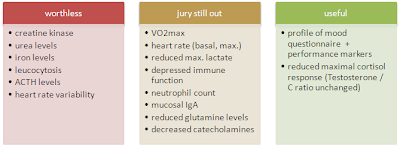The (Over-)Motivational Roots of Orthorexia, Overtraining & Co - Plus: Symptoms, Recovery Times & Scientific Questionnaire to Recognize Early Signs of Overtraining
 |
| Image 1: Does not look motivated, right? This kitty just knows about the value of carefully planned laziness! |
When it comes to motivation "over-" can be worse than "under-"
And while the Bulgarian athletes in the 1990s certainly had other "amotivational" factors they were suffering from than our friend Adelfo, his original motivation - his accident and the subsequent paraplegia - serve as a valid example that determination and the absolute will to achieve your aims is not only able to overcome adverse events, aka extrinsic amotvational factors, but that it is in your hands, or rather your mind, to turn remove the preceding "a-" and turn "a-motivation" into true motivation.
For some of you this may seem pretty irrelevant. A brief example and another piece of information from the Chantal study, will yet probably disabuse you. Let's assume you are working towards a 200lbs bench press, or trying to shed the notorious last inches of body fat from wherever they are bothering you and if I asked you "How motivated are you?", your answer would be "crazy" or "insanely motivated!" and "at least more motivated than the guy with the 250lbs bench press over there, man!" If you recognize yourself, you got something in common with the low performing top athletes from the Chantal study. They were across-the-board more (intrinsically) motivated than their peers.
 |
| Image 2: If you start avoiding going out with your friends because of the food, you are already in serious trouble and all the "healthy eating" you believe you do won't help that. |
Over-motivation and the slippery slope to serious health problems
Now, does that mean that being intrinsically motivated is a bad thing? That really wanting to achieve your aims in the absence of people putting spokes into your wheels is a disadvantage? Certainly not. Without appropriate motivation you are not going achieve anything in life. On the other hand, being highly motivated can be a double-edged sword - an in the case of exercise and nutrition, it very often is! A group of Italian researchers has recently published the findings of a large scale investigation into the dietary patterns of 577 athletes and came up with pretty unsettling results: 28% of the subjects scored high to very high on the so-called ORTO-15 test, a questionnaire that was developed to identify pathological eating behaviors characterized by the obsessive desire to eat healthy - or what the patients believe to be healthy.
Orthorexia nervosa or other eating disorders are yet by far not the only negative side effects of being over-motivated. A more subtle and yet in essence similar consequence which is the probably the most common cause of failure for the average gym rat is over-training - and this is true for both the obese (pre-)diabetic, as well as the lean workout machine. In both groups you will find those, who - often against better judgement - follow the "more is more and if that does not work better, I'll do even more" principle to overtraining, over-dieting, "chronic fatigue" and "adrenal burnout". Other than orthorexia, where your social environment will probably soon discover that something is getting out of hand (listen to the early warnings!), overtraining often goes unrecognized until the hole you have been digging for weeks, months and sometimes years is so deep that performance stagnation and decline are the least of your worries.
Is it even possible to recognize "overtraining" before it is too late?
The reasons for the difficulties trainees as well as trainers have to determine whether stagnation or decreases in performance are a result of "under-" or overtraining are manifold, one obviously is the mere necessity of overload to induce adaptation and thus increases in performance, muscle size and weight loss (the latter in response to "dietary underload" ;-) - the proverbial work in the park is getting you from one side of the park to the other, but not next to Adelfo on the stage. Unfortunately(?), the same holds true for the seven two-hour mega-workouts some people perform 52 weeks per year.
 |
| Figure 1: Brief overview of the different "types" of what often is referred to as "overtraining", the symptoms, and the average recovery times (based on Purvis. 2010) |
Mind over motivation! But can you identify when much becomes too much?
Against the background that Dianna Purvis and her colleagues from the Uniformed Services University of the Health Sciences, Bethesda, conclude in a 2010 review of the literature that we still don't have identified a "single factor" or found a reliable "diagnostic tool [...] to definitively establish a diagnosis".(Purvis. 2010), it is all the more important to tame your motivation and let reason prevail, when it comes to planning your nutrition and workout schedule.
 |
| Figure 2: Overview of selected biomarkers that have been investigated for their usefulness to idenfify over-reaching or overtraining (based on an overview in Purvis. 2010) |
And if you don't have a "profile of mood questionnaire" handy, but still believe in the power of evaluations based on 0-4 scales, I highly suggest you download the free staleness score test Dr. Jack Raglin developed for the US military. It's free, so don't be shy! Here you go for the download: "Training Distress Scale"


